Science Highlights, August 3, 2016
Awards and Recognition








- Nine Laboratory innovations selected as R&D 100 Award Finalists
- Entropy Engine
- HOSS (Hybrid Optimization Software Suite)
- MarsFS
- Photonic Band Gap Structures
- PuLMo (Pulmonary Lung Model)
- Turning Windows and Building Facades into Energy- Producing Solar Panels
- Virtual Environment for Reactor Applications (VERA)
Earth and Environmental Sciences
First use of seismic interferometry to study the Moon’s internal structure
Materials Science and Technology
Strain-gradient crystal plasticity model accounts for size effects in polycrystalline materials
Awards and Recognition
Nine Laboratory innovations selected as R&D 100 Award Finalists
A panel of judges selected by R&D Magazine has chosen nine Los Alamos innovations as Finalists for the 2016 R&D 100 Awards. These prestigious “Oscars of Invention” honor the top technological advances of the past year. R&D 100 Awards span industry, academia, and government-sponsored research. The Awards demonstrate the continued success of Laboratory researchers in technical innovation for national security science. This year’s honorees are the result of partnerships with private industry, universities, and other national laboratories, and illustrate many possible paths from scientific creativity to deployment of solutions. These developments also benefit the nations’ industrial competiveness. Private industry has licensed Entropy Engine, HOSS, and PathScan; Entropy Engine and PathScan are now commercially available products for cybersecurity applications
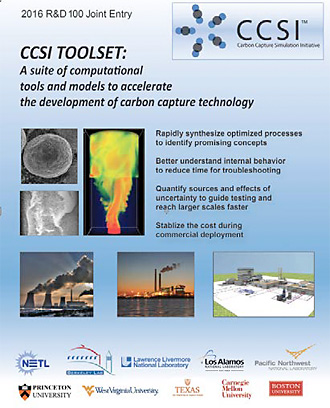
CCSI (Carbon Capture Simulation Initiative) Toolset
CCSI (Carbon Capture Simulation Initiative) Toolset is a suite of computational tools and models that supports and accelerates the development, scale-up, and commercialization of carbon dioxide (CO2) capture technology to reduce domestic and global carbon dioxide emissions. The invention addresses key industrial challenges, including developing a baseline for the uncertainty in simulation results, quantifying and reducing the level of uncertainty in processes, and options, enhances understanding of how processes will operate at scale under relevant field conditions, and increases understanding of how uncertainty affects risk. It is the only suite of computational tools and models specifically tailored to help maximize learning during the scale-up process in order to reduce risk. Maximizing the learning during pilot projects reduces the time needed for subsequent commercialization and enables greater investment confidence. The CCSI Toolset could also be employed in related industries to enable faster, more cost effective scale up of other new technologies.
The National Energy Technology Laboratory submitted the joint entry with Lawrence Berkeley National Laboratory, Lawrence Livermore National Laboratory, LANL, Pacific Northwest National Laboratory, Princeton University, West Virginia University, University of Texas at Austin, Carnegie Mellon University, and Boston University. Joel Kress (Physics and Chemistry of Materials, T-1) led the Los Alamos team, which included Jim Gattiker, Sham Bhat, and Peter Marcy (Statistical Sciences, CCS-6); Brett Okhuysen (Systems Design and Analysis, NEN-5); David DeCroix (Intelligence and Emerging Threats Program Office, GS-IET), and Susan Sprake (Richard P. Feynman Center for Innovation, FCI-DO). Technical contact: Joel Kress
Entropy Engine
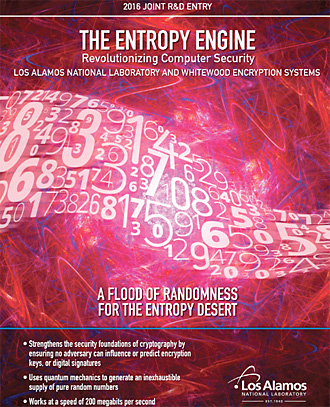
Entropy Engine is a random number generator that addresses a key fundamental flaw in modern crypto systems: predictability. The invention strengthens the foundation of computer security by producing an inexhaustible supply of pure random numbers at speeds of 200 million bits per second. Entropy Engine uses the unique properties of quantum mechanics to generate true entropy (random numbers) in a way that makes it immune from all external influences. The behavior of the universe at the smallest scale – the quantum level – is fundamentally unpredictable and makes the immunity possible. The new technology supplies a flood of trustworthy, verifiable truly random numbers, making it virtually impossible for even the most sophisticated cyber attackers to break into the assets protected by this technology.
Los Alamos submitted Entropy Engine as a joint entry with Whitewood Encryption Systems. Raymond Newell (Applied Modern Physics, P-21) led the Los Alamos team of Glen Peterson (P-21) and David Guenther (Space Electronics and Signal Processing, ISR-4), with collaborators Richard Moulds (Whitewood Encryption Systems), Jane E. Nordholt and Richard Hughes (retired Laboratory employees); Robert Van Rooyen (Summit Scientific Inc.), and Alex Rosiewicz (A2E Partners, Inc.). Technical contact: Raymond Newell
HOSS (Hybrid Optimization Software Suite)
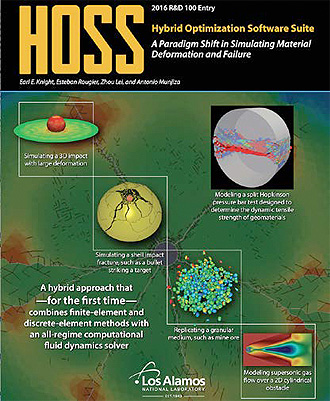
HOSS (Hybrid Optimization Software Suite) provides a simulation platform to conduct “virtual experiments” that help model and analyze materials phenomena that cannot be readily produced or studied in a laboratory or real-world setting. It is the first to combine finite-element and discrete-element methods with an all-regime computational fluid dynamics solver to generate accurate simulations of complex multi-physics problems, such as material deformation, fracture, and failure analyses. HOSS uses proprietary simulation tools on different length scales ranging from molecular and nano -scales to engineering and industrial scales to terr estrial-body and astrophysics scales. Its massively parallel platform enables researchers to conduct simulations on laptops, desktops, or supercomputers. HOSS simulates large-strain, large-displacement deformation of solid materials ranging from rubber to metals, rocks, biomedical materials and medical tissue (e.g., bone, blood vessels, and blood cells). For example, HOSS simulations can be used to predict the dynamic responses of buildings, structures, and windows to explosions and impact. This tool enables engineers to devise appropriate mitigation strategies. Earl E. Knight (Geophysics, EES-17) led the team of Esteban Rougier and Zhou Lei (EES -17) and Antonio Munjiza (TetCognition LTD). Technical contact: Earl Knight
MarsFS
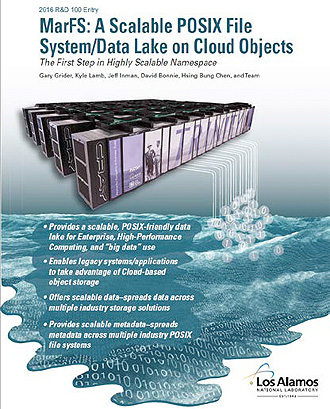
MarFS is a thin software layer that makes the technical advances generated by Cloud-based storage available to classical POSIX use cases. The acronym “MarFS” is a combination of the word “mar” (Spanish for “sea,” equivalent to the data lake) and “File System”. The inventors wrote MarFS specifically to leverage Cloud Storage technology for high performance parallel cold storage. The software maps directories and files in legacy systems, including those used by companies that handle vast amounts of data, to Cloud-based object storage. The legacy software sees its traditional mapping of files and directories (i.e., the legacy software operates fully within its expected legacy look and feel), while the scalability, resiliency, and efficiencies provided by Cloud-type storage are unleashed. MARFS is so flexible that it can adapt to new storage technologies as they are developed.
Gary Grider (High Performance Computing-Division Office, HPC-DO) led the team of Kyle E. Lamb, David Bonnie, and Hsing Bung Chen (High Performance Computing-Design, HPC-DES); Christopher Hoffman (High Performance Computing-Systems, HPC-SYS); Christopher DeJager, Jeff Inman, and Alfred Torrez (High Performance Computing Environments, HPC-ENV); and Brett Kettering (HPC-DO). Technical contact: Gary Grider
Photonic Band Gap Structures
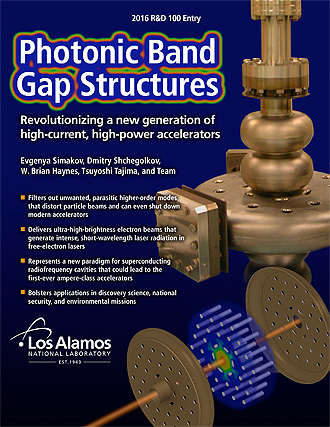
Photonic Band Gap Structures enables a new generation of high-current, high-power accelerators. Today, there are more than 30,000 particle accelerators operating around the world for use in basic science and applications in medicine, energy, environment, national security and defense. These accelerators use electromagnetic fields to propel charged particles to nearly the speed of light, containing the particles in well-defined beams. Creating a more compact and cost-effective accelerator requires the ability to achieve high accelerating gradients in higher-frequency accelerating structures. The principal roadblock for development is that at high frequencies, the higher order modes (parasitic, high-frequency oscillations of the accelerator structure) become excited by the very particle beam that propagates through the accelerating structure. The higher-order modes deteriorate a beam’s quality and intensity. The Laboratory developed photonic band gap structures to filter out the parasitic higher-order modes, which are considered to be the greatest obstacle in achieving higher intensity, more reliable, and cost-effective particle accelerators. The resulting photonic band gap accelerating cavities improve a beam’s quality and intensity. The technology operates at high accelerating frequencies, opening the way to the construction of compact and lightweight accelerators.
Evgenya Simakov (Accelerators and Electrodynamics, AOT-AE) led a team that includes W. Brian Haynes (Radio Frequency Engineering, AOT-RFE), Dmitry Shchegolkov and Sergey Arsenyev (AOT-AE), and Tsuyoshi Tajima (Mechanical Design Engineering, AOTMDE). Technical contact: Evgenya Simakov
PuLMo (Pulmonary Lung Model)
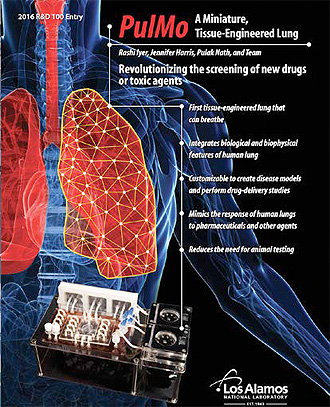
PuLMo (Pulmonary Lung Model) is a miniature, tissue-engineered lung developed to revolutionize the screening of new drugs or toxic agents. Current screening methods often use different types of animals, which may not be accurate predictors of the response in humans. PuLMo is 1/1000th the size of an actual human lung. Such miniaturization makes it possible to evaluate multiple units at a time and to create models for different lung-specific disease conditions. PuLMo could be used as a platform to study the flow dynamics of particles inside a lung for applications in drug delivery and particle/pathogen deposition studies. It could also serve as a realistic multicellular pulmonary model for performing fundamental research to understand disease morphology and host-pathogen interactions. The invention has the potential to make screening of new drugs more effective by improving the reliability of pre-clinical testing and saving time, money, and lives. PuLMo could reduce and eventually eliminate the use of animals in pharmaceutical testing.
Rashi S. Iyer (Information Systems and Modeling, A- 1) led the team of Pulak Nath (Applied Modern Physics, P-21), Jennifer Foster Harris, Ayesha Arefin, Yulin Shou, Kirill A. Balatsky, and Jen-Huang Huang (Biosecurity and Public Health, B-10); Srinivas Iyer (Bioscience Division Office, B-DO); Jan Henrik Sandin (Instrumentation and Controls, AOT-IC); David Platts and John Avery William Neal (P-21); Timothy Charles Sanchez (Bioenergy and Biome Sciences, B-11); and Miranda Huang Intrator (Richard Feynman Center for Innovation, FCI-DO). Technical contact: Rashi Iyer
Turning Windows and Building Facades into Energy- Producing Solar Panels
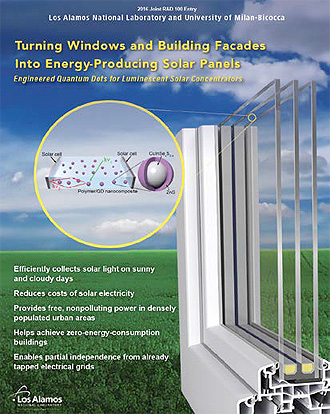
Turning Windows and Building Facades into Energy- Producing Solar Panels: Engineered Quantum Dots for Luminescent Solar Concentrators. These revolutionary semitransparent windows contain highly emissive semiconductor nanocrystals (quantum dots) that collect sunlight for edge-installed photovoltaics and provide a desired degree of shading. The material can turn windows and building facades into electrical generators of nonpolluting power. The dots absorb the sunlight, re-emit it at a longer wavelength, and waveguide it towards edge-installed photovoltaic cells for production of electricity. As a result of this technology, once passive building facades could be transformed into power-generation units, which would be particularly useful in densely populated areas. Unlike other solar energy harvesting technologies with quantum dots, a key element of this technology involves the use of nontoxic copper indium selenide sulfide (CuInSexS2-x) quantum dots. This material is easily fabricated and processed into devices that enable the highly efficient harvesting of broadband solar radiation, provide a perfect spectral match to silicon photovoltaics, and prevent alteration of color perception.
Los Alamos submitted the joint entry with the University of Milano-Bicocca as a co-developer. Victor I. Klimov (Physical Chemistry and Applied Spectroscopy, C-PCS) led the team of Kirill Velizhanin (Physics and Chemistry of Materials, T-1), Hunter McDaniel (former LANL Postdoctoral Researcher, currently with UbiQD LLC), Sergio Brovelli and Francesco Meinardi (University of Milano-Bicocca). Technical contact: Victor Klimov
Virtual Environment for Reactor Applications (VERA)
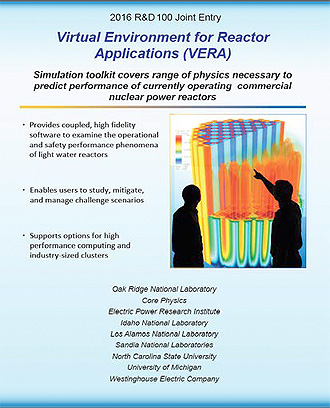
Virtual Environment for Reactor Applications (VERA) provides coupled, high fidelity, software capabilities to examine light water reactors’ operational and safety performance-defining phenomena at levels of detail previously unattainable. The multiphysics simulation toolkit covers the range of physics necessary to predict the performance of currently operating commercial nuclear power reactors. This capability enables users to study, mitigate, and manage the challenge problems identified by the industry to a level of understanding that is not available through other toolsets. VERA supports options for both high performance computing and industry-sized computing clusters in a manner that is accessible and easily understood for most users.
Oak Ridge National Laboratory submitted VERA, a joint entry with Core Physics, Electric Power Research Institute, Idaho National Laboratory, Los Alamos National Laboratory, Sandia National Laboratories, North Carolina State University, University of Michigan, and Westinghouse Electric Company. Christopher Stanek of Materials Science in Radiation and Dynamics Extremes led the Los Alamos work. Technical contact: Christopher Stanek
Accelerator Operations and Technology
Microstructure of a candidate accident-tolerant nuclear fuel
Following the Fukushima Daiichi disaster, there has been interest in developing new accident-tolerant nuclear fuels with improved properties. In the event of an accident, these fuels would increase the coping time beyond what is possible with current fuel-clad systems. Compared with conventional uranium oxide (UO2), new accident-resistant fuels could potentially offer improvements in thermal conductivity, ductility, mechanical strength, density, and resistance to oxidation.
LANL researchers, in collaboration with the Idaho National Laboratory, are fabricating a variety of candidate systems for consideration. New fuels must be cost effective and compatible with existing fabrication tools and nuclear power plants. Characterizing properties is the first step in certifying a new fuel type. In addition to conventional approaches, the team has – for the first time – used high-energy (88-KeV) x-rays to map 3-D microstructures in samples of a candidate accident-tolerant fuel. This approach provides efficient and non-destructive mesoscale characterization of the starting properties of the nuclear fuel before exposure to the extreme conditions of a nuclear reactor.
UN-U3Si5 (N is nitrogen, and Si is silicon) is one of several accident-tolerant nuclear fuels concepts under consideration. The team fabricated the fuels at the Fuels Research Laboratory in Engineered Materials (MST-7) at LANL. The 3-D data gathered through high-energy diffraction microscopy and computed micro-tomography will be crucial for fuel performance model development. Ultimately such measurements can be applied nondestructively to observe the microstructural evolution of a single sample under a range of conditions. The results will test and calibrate the validity of predictive models.
The high Z uranium material requires the energy and fluence of synchrotron x-rays available at the Advanced Photon Source (APS) at Argonne National Laboratory for these studies. The team used diffraction and transmission x-ray data to characterize the as-fabricated state of the sample. Figure 8 presents information on spatially resolved orientations, grain sizes (typically about 20 microns) and shapes, and phases. A volumetric density map shows the two expected phases and reveals the presence of a third phase, consistent with electron microscopy. The team identified porosity at the level of about 1.4 volume %. Researchers performed complementary neutron imaging on samples of the same composition at the Los Alamos Neutron Science Center to measure enrichment levels and characterize macroscopic features that exist in full-scale pellets. The investigators will perform measurements on samples prepared under different conditions (composition, time, temperature, pressure, etc.) to determine the fabrication route most suitable to obtain fuel with the desired structures and properties.
Techniques such as these would be an integral capability at MaRIE (Matter-Radiation Interactions in Extremes), the Laboratory’s proposed experimental facility for time-dependent materials science at the mesoscale. The heart of MaRIE would be the world’s most advanced free electron laser (FEL), an x-ray source orders of magnitude brighter than existing synchrotron facilities, providing fully coherent light at shorter wavelengths than is currently available at existing FELs. The measurements described above required many hours per sample. They could be completed in fractions of a second at MARIE and would enable the measurement of thousands of states of a single sample. This would provide a view into sample evolution under strain or thermal loading at previously inaccessible time-scales and levels of detail. Moreover, the full transverse coherence of the MaRIE light (all of the produced photons will be traveling almost exactly in phase relative to each other) would enable truly dynamic measurements of bulk materials under extreme conditions.
Researchers include Reeju Pokharel and Don Brown (Materials Science in Radiation and Dynamics Extremes, MST-8), Timothy Ickes and James Hunter (Applied Engineering, Technology, AET-6), and Andy Nelson, Stew Voit, and Scott Parker (Engineered Materials, MST-7).
The DOE Fuel Cycle R&D program provided the material for this study. The work, which supports the Laboratory’s Energy Security mission area and the Materials for the Future science pillar, received funding from the DOE Office of Nuclear Energy. Technical contact: Reeju Pokharel
Bioscience
New, reversibly photoswitching chromogenic protein developed
New, reversibly photoswitching chromogenic protein developed Laboratory researchers and collaborators have evolved and characterized a new, reversibly photoswitching chromogenic protein that could enable a multitude of applications and research possibilities. The Journal of Molecular Biology published their research.
Scientists have taken advantage of a green-glowing, barrel-shaped protein called GFP (green fluorescent protein) for decades. Green fluorescent protein was isolated from Aequorea victoria jellyfish in the 1960s and 1970s. The original GFP and similar fluorescent proteins are used in biological research as reporters of gene expression or protein folding, or of reactivity in biosensors. A protein that can actively switch between fluorescent and non-fluorescent states is even more useful than a protein that glows when it is folded correctly. Photoswitching fluorescent proteins are especially valuable due to the versatility of their function to report more than one state of an interaction.
Andrew Bradbury (Biosecurity and Public Health, B-10) led a team using directed evolution to modify thermostable versions of GFP (proteins they had also evolved) into a new protein with two spectrally distinct chromogenic states. They named the new protein “Dathail”, the Gaelic word for colorful. In contrast to all previously described photoswitchable proteins, both spectral states of Dathail are non-fluorescent and have low quantum yields corresponding to absorbance in a ground state with a maximum of 389 nm and a photo-induced metastable state with a maximum at 497 nm.
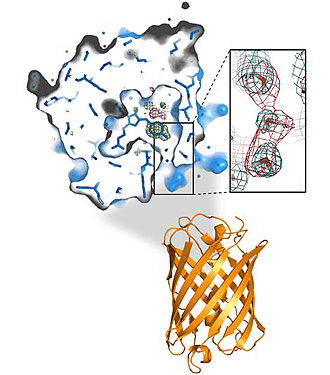
Figure 1. X-‐ray (blue) and neutron structures (boxed panel) of a new photoswitchable chromoprotein, Dathail, reveal the protonation state of its chromophore, and the presence of a water channel from the chromophore to the bulk solvent. Protein ribbon structure (orange) depicts the barrel view of Dathail’s metastable state.
The researchers used x-ray and neutron crystallography to characterize the photoswitching mechanism. X-ray crystallography provided structural insights supporting a change in conformation and coordination in the chromophore pocket as being responsible for Dathail’s photoswitching. Neutron crystallography, carried out for the first time on a protein from the green fluorescent protein family, showed a distribution of hydrogen atoms that reveal protonation of the chromophore 4-hydroxybenzyl group in the ground state. The neutron structure also supports the hypothesis that the photo-induced proton transfer from the chromophore occurs through water-mediated proton relay into the bulk solvent.
Dathail has several characteristics that are improvements in terms of applications. These include low background fluorescence, large spectral separation, rapid switching time, and the ability to switch states many times. These performance enhancements suggest that Dathail could be extremely useful in the rapidly developing fields of imaging and biosensors, including photochromic fluorescence resonance energy transfer (pcFRET), high-resolution microscopy, and live tracking within the cell. The structural and mechanistic insights reported in the publication may help in rationally engineering a more diverse population of reversibly switchable chromoproteins and photoswitching fluorescent proteins for improved biotechnology and imaging applications.
Reference: “Evolution and Characterization of a New Reversibly Photoswitching Chromogenic Protein, Dathail,” Journal of Molecular Biology 428, 1776 (2016); doi:10.1016/j.jmb.2016.02.029. Authors: Patricia S. Langan (B-10 and University of New Mexico), Devin W. Close [B-10, Center of Integrated Nanotechnologies (MPA-CINT), and ARUP Laboratories Institute for Clinical and Experimental Pathology], Leighton Coates and Andrey Kovalevsky (Oak Ridge National Laboratory), Reginaldo C. Rocha and Koushik Ghosh (MPA-CINT), Csaba Kiss [B-10, now Information Systems and Modeling (A-1)], Geoff Waldo (B-10), James Freyer (University of New Mexico), and Andrew R. M. Bradbury (B-10). Laboratory Directed Research and Development (LDRD) sponsored the Los Alamos work, which supports the Lab’s Global Security mission area and the Science of Signatures science pillar. This research used resources of the Oak Ridge National Laboratory Spallation Neutron Source, which is a DOE Office of Science User Facility. Technical contact: Andrew Bradbury
Chemistry
Origin of high solar cell efficiency in hybrid perovskites
Laboratory researchers and a collaborator have discovered why solution-processed, large-grain hybrid (organic/inorganic) perovskites produce solar cells with exceptional (approximately 18%) power conversion efficiencies. This class of materials offers low-cost solution processing preparation together with favorable intrinsic properties for optoelectronic applications. The journal Advanced Functional Materials published the findings.
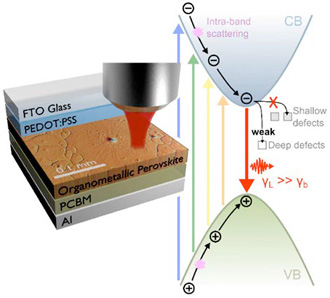
Figure 2. (Left): Illustration of the optical experiments conducted to discover the nature of charge carriers in hybrid perovskite thin films. (Right): A schematic of the electronic bands in the hybrid perovskite material with relevant relaxation processes. The rate of charge recombination in the material is much less than rate of charge extraction in a device.
The team discovered that charge carriers created by light are not free electrons and holes. Instead, they are manifested as “large” polarons, a more massive entity resulting from long-range interactions between photo-excited charges and polar molecules of the hybrid perovskite lattice. The large polaron has interesting physical properties that result in effective “shielding” from optical phonons and electronic impurities that are otherwise detrimental for efficient transport in semiconducting materials. This explains the superior transport properties of hybrid-perovskites compared with other solution-processed semiconducting materials, such as polymers and nanoparticles.
This is the first study that carefully addresses the intrinsic optoelectronic properties of large grain perovskites under solar cell operation conditions. The team used confocal time-resolved photoluminescence spectroscopy to examine the dynamics of photoexcited charge carriers in the organic-inorganic perovskite thin films. They found that the devices illuminated with sunlight operate in a bimolecular regime, where the free recombination of two spatially separated opposite charge carriers is the only relaxation pathway. The bimolecular recombination process is surprisingly efficient and comparable with that of high quality, defect-free direct bandgap IIIV semiconductors, like gallium arsenide, which are produced through more costly fabrication methods. The recombination is much slower than the transient time of charges to electrodes in devices that capture photocurrent, making overall charge extraction much more efficient than recombination.

Figure 3. Comparison of the properties of a large polaron (left) and an electron (right). The velocity of a large polaron is much less than that of a free charge, and its momentum is much larger than that of a free charge. This type of excitation enables material defects to be less important in transport processes and allows for efficient charge extraction under the applied electrical fields that are found in optoelectronic devices.
The findings bridge the gap between the microscale optical properties and macroscale solar cell performance of crystalline methylammonium halide thin films. The results demonstrate that devices based on solution processed thin film semiconductors could be operated in regimes free of impurities that degrade transport and alter optical properties. This discovery is an important step toward creation of solution-processed semiconductors that have properties comparable to materials grown by traditional high temperature methods. The hybrid nature of these materials leads to new physical phenomena involving charge carriers that are not observed in either organic or inorganic systems alone. Hybrid perovskite materials have excellent optoelectronic properties that enable a wide variety of potential device applications. The research gives the team insight to develop this material for U.S. energy and global security applications, such as solar cells and sensors.
Reference: “The Effects of Electronic Impurities and Electron-hole Recombination Dynamics on Large-grain Organic-inorganic Perovskite Photovoltaic Efficiencies,” Advanced Functional Materials 26, 4283 (2016); doi: 10.1002/adfm.201505324. Authors: Jean-Christophe Blancon and Jared Crochet (Physical Chemistry and Applied Spectroscopy, C-PCS), Wanyi Nie, Amanda Neukirch, Gautam Gupta, and Aditya Mohite (Materials Synthesis and Integrated Devices, MPA- 11); Sergei Tretiak (Physics and Chemistry of Materials, T-1); and Laurent Cognet (Université de Bordeaux).
The Laboratory Directed Research and Development (LDRD) program and the U.S. DOE, Office of Science, Energy Frontier Research Center for Advanced Solar Photophysics at LANL funded different aspects of the Los Alamos work, and Laboratory Institutional Computing provided computational resources. The work supports the Lab’s Energy Security and Global Security mission areas and the Materials for the Future science pillar. Technical contact: Jared Crochet
Earth and Environmental Sciences
First use of seismic interferometry to study the Moon’s internal structure

Photo. Astronaut Buzz Aldrin installs a seismometer on the Moon. Photo credit: NASA.
Charlotte Rowe (Geophysics, EES-17) and co-authors from the Delft University of Technology have reported the first use of the seismic interferometry technique applied to study the internal structure of the Moon. The Journal of Geophysical Research: Planets published the research and featured it as an Editor’s Highlight.
Astronauts installed seismometers on the near side of the Moon during the NASA Apollo missions. The instruments transmitted continuous seismic data to the Earth between July 1969 and September 1977. Early analysis of seismic methods (e.g., travel time analysis, receiver functions, and tomography) identified natural moonquakes: meteoroid impacts, thermal moonquakes, shallow moonquakes, and deep moonquakes.
Rowe and collaborators made the first use of deep moonquake seismic interferometry (DMSI) to examine the internal structure of the Moon. Obtaining virtual reflection responses of the Moon beneath the Apollo stations obviates the need for active seismic sources, such as explosives and artificial impacts recorded by the Apollo instruments. Seismic interferometry creates new seismic responses by cross-correlating seismic observations at different receiver locations. The team aimed to identify the lunar seismic Moho (Mohorovičić discontinuity, the boundary between the crust and the mantle). Knowledge of the crustal thickness is important for understanding the genesis and evolution of the Moon. It has implications for bulk composition, origin of rocks, and other aspects of lunar evolution.
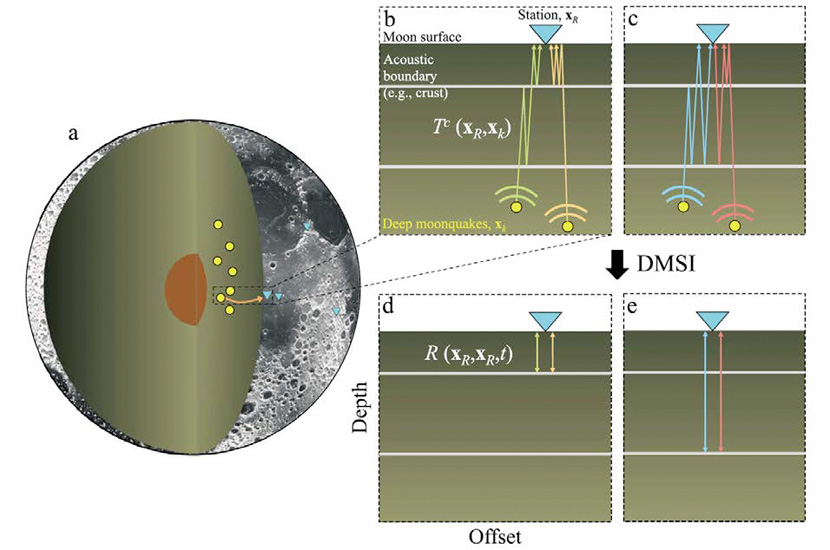
Figure 4. Illustration of how deep moonquake seismic interferometry works. (a): Deep moonquake clusters (yellow circles) closest to an Apollo station (blue triangles) are selected based on their incidence angle to the station. (b and c): Schematic raypaths of various types of P reverberations between high-impedance structural layers. (d and e): Cartoon of retrieved zero-offset plane wave from autocorrelation of hypothetical paths in (b) and (c) respectively.
The researchers were the first to use body-wave seismic interferometry to study deep moonquakes (hypocenters at depths between 700 and 1200 km). The team applied seismic interferometry to P wave codas (the seismic record of scattered, reflected, and refracted energy following the onset of the P wave but before the arrival of the S wave) of deep moonquakes recorded by the Apollo seismic stations to retrieve a reflection image of the Moon’s subsurface. The investigators analyzed the P wave coda of seven clusters of deep moonquakes whose incoming wavefronts of the direct P wave phases are approximately planar at the stations, and whose ray parameters are sufficiently small. The results of this study reveal a laterally coherent acoustic boundary at a depth of about 50 km below the Apollo seismic stations, which the researchers interpreted as the lunar seismic Moho. The information provides an independent estimate of the thickness of the lunar crust. The authors suggest that deep moonquake seismic interferometry could be extended to imaging the subsurface below seismic stations on the far side of the Moon if future missions install them.
Reference: “Reflection Imaging of the Moon’s Interior Using Deep-Moonquake Seismic Interferometry,” Journal of Geophysical Research: Planets 121, 695 (2016); doi: 10.1002/2015JE004975. Authors: Yohei Nishitsuji, Kees Wapenaar, and Deyen Draganov (Delft University of Technology); and C. A. Rowe (EES-17).
The NNSA Ground-Based Nuclear Detonation Detection program (GNDD) sponsored the Los Alamos portion of the research. Capabilities developed and used in this analysis support the Lab’s Global Security mission area and the Science of Signatures science pillar through the ability to investigate earth structure and determine the location and magnitude of earthquakes and underground explosions. Technical contact: Charlotte Rowe
Materials Physics and Applications
Quantum criticality in a low-carrier system
The easily tuned balance among competing interactions in Kondo lattice metals allows access to a zero-temperature, continuous transition between magnetically ordered and disordered phases, called a quantum-critical point (QCP). These highly correlated electron materials are prototypes for discovering and exploring quantum critical states. Theoretical models proposed to account for the strange thermodynamic and electrical transport properties that emerge around the QCP of a Kondo lattice assume the presence of an indefinitely large number of itinerant charge carriers. In a paper published in the Proceedings of the National Academy of Sciences of the United States of America, Los Alamos researchers and collaborators report that pressure- and field-induced zero-temperature magnetic phase transitions in CeNi2−δAs2 emphasize the previously unappreciated importance of a low-carrier density on the nature of quantum-phase transitions and the signatures of quantum criticality. Conditions leading to a local type of quantum criticality have remained uncertain since evidence for it was discovered nearly 20 years ago.
Quantum criticality is a powerful organizing principle for discovering new quantum states, such as superconductivity, that have an energy-saving functionality far above zero temperature.
However, there is no accepted theory of quantum criticality in metallic materials. The publication shows for the first time that that nature of quantum criticality depends sensitively on the density of electronic charge carriers in a metal. This discovery is a significant step toward harnessing the organizing principle of quantum criticality to realize energy efficiencies offered by the quantum states of electrons that form from quantum criticality.
An unconventional quantum-critical point involves a critical destruction of the Kondo entanglement and a reconstruction of Fermi surface topology. A description of such quantum criticality requires a broader experimental basis and a theoretical model that includes critical fermionic degrees of freedom. The study of CeNi2−δAs2 reveals – for the first time – that a sufficient condition for local quantum criticality is a low-carrier density and that consequences of this condition should be considered explicitly in models of criticality. The research provides a rare example of peculiar quantum-critical behavior in the low-carrier density limit. The similarity between the CeNi2−δAs2 and the well-known quantum-critical Kondo lattice system CeCu6−xAux indicates that a condition favorable for the unconventional quantum criticality is a “small” Fermi volume that disfavors the conventional Hertz–Millis-type spin density wave criticality. This insight provides new guidance to search for additional examples of unconventional quantum criticality.
Reference: “Pressure-Tuned Quantum Criticality in the Antiferromagnetic Kondo Semimetal CeNi2−δAs2,” Proceedings of the National Academy of Sciences of the United States of America 112, 13520 (2015); doi: 10.1073/pnas.1509581112. Authors: Yongkang Luo, Filip Ronning, Nicholas Wakeham and Joe David Thompson, (Condensed Matter and Magnet Science, MPA-CMMS); Xin Lu and Z.-A. Xu (Zhejian University, China); and Tuson Park (Sunkyunkwan University, South Korea). This material is based upon work supported by the U.S. Department of Energy, Office of Science, Office of Basic Energy Sciences, Materials Sciences and Engineering Division. A Los Alamos National Laboratory Director’s postdoctoral fellowship funded Yongkang Luo. The research supports the Laboratory’s Energy Security mission area and the Materials for the Future science pillar. Technical contact: Yongkang Luo
Materials Science and Technology
Strain-gradient crystal plasticity model accounts for size effects in polycrystalline materials
Many materials of interest for the Lab are polycrystals. Crystal plasticity (CP) is an essential modeling tool to predict the mechanical behavior of this class of materials, based on knowledge of the physical mechanisms governing single crystal deformation. CP formulations serve as a bridge between lower length-scale experiments and models, and engineering applications requiring microstructure-sensitive descriptions of the material’s strength and damage.
Ricardo Lebensohn (Materials Science in Radiation and Dynamics Extremes, MST-8) and Alan Needleman (Texas A&M University) developed a numerical implementation of a strain-gradient crystal plasticity theory that addresses and solves known limitations of previous CP models. The new formulation is based on a spectral solution of the underlying partial differential equations governing the micromechanics of heterogeneous media, making it much more efficient than previously available CP numerical codes. The computation efficiency gain is particularly critical, given the non-local character of the new CP model. Non-locality, in the form of strain gradients affecting the single-crystal constitutive behavior, allows consideration of size effects not captured by standard CP formulations, at the expense of a more complex and numerically demanding implementation. The Journal of the Mechanics and Physics of Solids published the research.
Accounting for size effects is particularly relevant to model mechanical behavior of nanostructured materials and grain boundary effects on plasticity. With the new approach, size-dependent plasticity of polycrystalline materials can be modeled with an unprecedented level of detail in three dimensions. Figure 6 depicts the strain fields predicted by the new model in the case of tensile deformation of polycrystalline copper with different (penetrable vs. impenetrable, vis-a-vis dislocation transmission) grain boundary properties, and the predicted size effect on the mechanical response of polycrystalline copper in the case of impenetrable grain boundaries, which becomes harder as the grain size d becomes smaller. The results indicate that the developed fast Fourier transforms (FFT) method provides a promising basis for the accurate and efficient calculation of polycrystal response accounting for grain size effects due to slip gradients.
Reference: “Numerical Implementation of Non-Local Polycrystal Plasticity using Fast Fourier Transforms,” Journal of the Mechanics and Physics of Solids, in press (2016; doi: 10.1016/j.jmps.2016.03.023. Authors: Ricardo A. Lebensohn (MST-8) and Alan Needleman (Texas A&M University).
Lebensohn is co-developer of the widely-used Visco-Plastic Self-Consistent (VPSC) polycrystal plasticity code, and the developer of the FFT-based formulation used in the work. Needleman is a member of the National Academy of Engineering and a professor at Texas A&M University. He pioneered the fields of crystal plasticity (Asaro-Needleman formulation) and dilatational plasticity (Gurson-Tveergard-Needleman formulation).
The Laboratory Directed Research and Development (LDRD) program, “Mesoscale Materials Science of Ductile Damage in Four Dimensions,” and the NNSA Advanced Simulation and Computing (ASC) Physics and Engineering Models, Materials Project funded different aspects of the work. The research supports the Laboratory’s Nuclear Deterrence mission area and the Materials for the Future science pillar through development of methods to model the mechanical behavior of polycrystalline materials. Technical contact: Ricardo Lebensohn
Physics
Researchers polarize protons to study sea quark dynamics
Members of Subatomic Physics (P-25) in collaboration with the University of Virginia (UVa) have developed a novel polarized target to determine a possible contribution of sea angular momentum to the nucleon spin. Past experimental measurements have shown that about half of the spin of the proton comes from the spin of its quarks and gluons. Recent theoretical and experimental efforts have focused on how the orbital angular momentum of the quarks and gluons also contribute to the proton’s spin. These efforts show that the orbital angular momentum contribution of the sea quarks (antiquark, a type of anti-matter) could be large. The upcoming E1039 experiment at Fermilab National Accelerator Laboratory will study the dynamics of sea quarks in the proton. The experiment will access the sea quark Sivers function by measuring Drell-Yan pairs produced using a 120-GeV unpolarized proton beam directed on a transversely polarized target. A non-zero Sivers function would indicate a contribution of the sea quark orbital angular momentum to the spin of the proton.
Scientists in P-25, collaborating closely with the polarized target team at UVa, are responsible for developing and testing the E1039 polarized target system. P-25 scientists are also creating a new polarization measurement technique.
Polarizing protons for use in studying these nuclear effects is an established, but challenging procedure. Proton samples need a high magnetic field of 5 T and low temperature (approximately 1 K) just to reach a polarization of only 0.5%. Through a process called dynamic nuclear polarization, protons in a paramagnetic material can reach higher polarization when bombarded with microwave radiofrequency (RF) for up/down polarization. For example, protons in the hydrogen atoms of irradiated ammonia (NH3) can reach polarization levels of greater than 90%. A nuclear magnetic resonance (NMR) technique measures the polarization of protons. In NMR, a RF signal at the larmor frequency of the proton is sent through a resistor-inductor-capacitor circuit where a coil is embedded in the target material. As the number of protons in a particular state increases, the voltage across the circuit increases/decreases for absorption/emission of RF, indicating a net spin up/down polarization of the protons.
Andi Klein and David Kleinjan (P-25) and the UVa collaborators successfully measured a proton polarization of 90% at the UVa polarization lab. Los Alamos provided the polarized target system, which is composed of a 5 T superconducting magnet and a refrigerator that delivers cooled liquid helium at 1 K to the target chamber located in the 5 T field. The team first brought the polarized target system to 5 T and 1 K. Then they put the irradiated NH3 material in this high magnetic field, low temperature environment.
The new NMR system developed at LANL by Pat McGaughey and Jacqueline Mirabal-Martinez (P-25) successfully measured the thermal equilibrium polarization, which is needed as a baseline. A microwave RF enabled dynamic nuclear polarization. Then the NMR system measured the real time polarization increase, up to 90%. The established UVa Liverpool Q-meter NMR system ran in parallel and showed good agreement with the new LANL NMR system. The team developed the NMR system because the Liverpool system is no longer manufactured, and the NMR system measures to better accuracy. The working polarized target will enable the E1039 installation to start soon. The data will be crucial in understanding the origin of the proton spin.
This fundamental science project supports the Lab’s Nuclear and Particle Futures and Science of Signatures science pillars by developing experimental techniques for particle detection and data acquisition and data analysis. The Laboratory Directed Research and Development (LDRD) program funds the LANL portion of the work. Technical contacts: Andi Klein and David Kleinjan
Theoretical
Machine learning accelerates the discovery of new materials
Los Alamos researchers and collaborators demonstrated how an informatics-based adaptive design strategy, tightly coupled to experiments, could accelerate the discovery of new materials with targeted properties. Intuition and trial-and-error typically guided the search for new materials prior to this strategy. However, the combination possibilities become far too large for trial-and-error approaches to be practical for increasing chemical complexity. The journal Nature Communications published the team’s research.
Turab Lookman (Physics of Condensed Matter and Complex Systems, T-4), led the project, which demonstrated that starting with a relatively small data set of well-controlled experiments, it is possible to iteratively guide subsequent experiments toward finding the material with the desired target properties. To address the issue of trial-and-error approaches to discovery, the team employed machine learning to accelerate the process. They developed a framework that uses uncertainties to iteratively guide the next experiments to be performed in search of a shape memory alloy with very low thermal hysteresis (or dissipation). Such alloys are critical for improving fatigue life in engineering applications.
The researchers aimed to cut the time and cost by one-half in bringing materials to market. Their work demonstrated that a data-driven framework built on the foundations of machine learning and design could lead to much faster discovery of new materials with targeted properties.
Although the Materials Genome initiative, issued by the White House Office of Science and Technology Policy in 2011, catalyzed interest in accelerated materials discovery, this study is one of the first to demonstrate how an informatics framework could actually lead to the discovery of new materials. The interplay of structural, chemical and microstructural degrees of freedom introduces enormous complexity, especially if defects, solid solutions, nonstoichiometry and multi-component compounds are involved. Current state-of-the-art tools cannot handle this complexity. Moreover, few prior studies included any feedback to experiments or a means to incorporate uncertainties.
The strategy, which the researchers used for the discovery of optimized nickel-titanium-based shape-memory alloys, could be used for any class of material (polymers, ceramics or nanomaterials) or target properties (e.g., dielectric response, piezoelectric coefficients and band gaps). This is crucial when experiments or calculations are costly and time-consuming. Although the work focused on the chemical exploration space, it could be readily adapted to optimize processing conditions when there are many “tuning knobs” controlling a figure of merit, as in advanced manufacturing applications. Similarly, it could be generalized to optimize multiple properties.
Reference: “Accelerated Search for Materials with Targeted Properties by Adaptive Design,” Nature Communications 7, 11241(2016); doi: 10.1038/ncomms11241. Authors: Deshen Xue (Physics of Condensed Matter and Complex Systems, T-4 and Jiaotong University), Prasanna V. Balachandran (T-4), John Hogden (Information Sciences, CCS-3), James Theiler (Space Data Science and Systems, ISR-3), Dequing Xue (Jiaotong University), and Turab Lookman (T-4). The Laboratory Directed Research and Development (LDRD) program funded the Los Alamos investigators’ work, and the Laboratory provided Institutional Computing resources. The research supports the Lab’s Energy Security mission area and the Materials for the Future and Information, Science and Technology science pillars through the development of accelerated methods to discover new materials with specific properties. Technical contact: Turab Lookman





